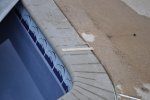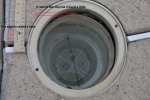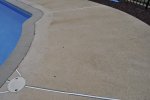This pool was built by previous owner about 5-6 years ago. This is going to be my 2nd summer.
I have this gap around the whole pool and I believe this gap is getting bigger(or may be I just started paying too much attention to it). Guys who closed my pool last fall said they have never seen a gap like this and it must be filled otherwise pool surface my start falling. What do you guys think? Does this gap need to be filled and if so, what does it need to be filled with?
Thanks
I have this gap around the whole pool and I believe this gap is getting bigger(or may be I just started paying too much attention to it). Guys who closed my pool last fall said they have never seen a gap like this and it must be filled otherwise pool surface my start falling. What do you guys think? Does this gap need to be filled and if so, what does it need to be filled with?
Thanks






 While it's not a problem now, the freeze/ thaw cycle will only exacerbate the cracks as the years go by
While it's not a problem now, the freeze/ thaw cycle will only exacerbate the cracks as the years go by